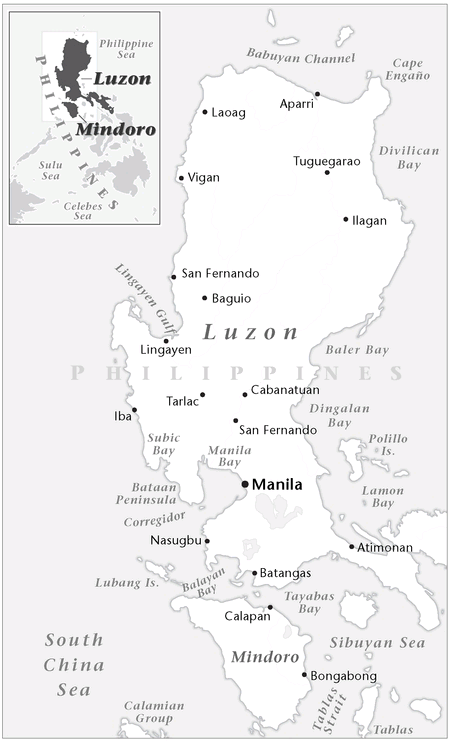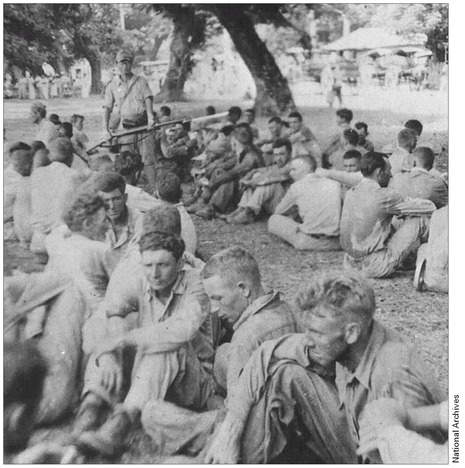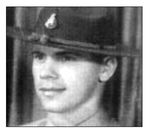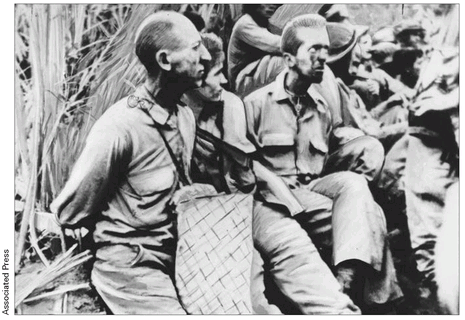War Stories II (11 page)
Authors: Oliver L. North

Reluctantly, the Japanese accepted the unconditional surrender of only King's troops on Bataanâbut not those still holding out on Corregidor. When asked to surrender his sword, an act of great significance for the Japanese, King had to admit that he'd left his ceremonial saber in Manila. Instead, he took his Colt .45 automatic sidearm and laid it on the table.
General King had now officially surrendered his troops, 66,000 Filipinos and 12,000 Americans. He believed that by surrendering, he had prevented a bloodbath. It was the largest contingent of U.S. Army troops ever to surrender to a foreign adversary. The only comparable event was the surrender of General Lee's army in the Civil Warâthat, coincidentally, had taken place at Appomattox on the very same day in 1865.
 JAPANESE POW COLUMN
JAPANESE POW COLUMNBATAAN PENINSULA, PHILIPPINES
8 APRIL 1942
1700 HOURS LOCAL
8 APRIL 1942
1700 HOURS LOCAL
By 1600 on the day General King surrendered his army, it had begun. All along the Bataan front, Americans and their Filipino allies were laying down their weapons and moving out onto roads and tracks in the muddy jungle to be placed in clusters of several hundred in long columns by Japanese soldiers. It quickly became apparent that their conquerors had no intention of abiding by any of the civilized norms for the treatment of prisoners of war (POWs).
For his part, General Masaharu Homma had a hopeless problem. He had no idea how to handle this many prisoners. Tokyo had given him instructions for how to deal with 25,000 prisoners, not the 78,000-plus that he now hadâand that worried him. He had insufficient food, water,
medicine, and transport for his own menâhow could he possibly care for this many prisoners? And most troubling of all, he was already five months behind Tokyo's war plan schedule.
medicine, and transport for his own menâhow could he possibly care for this many prisoners? And most troubling of all, he was already five months behind Tokyo's war plan schedule.
Homma devised the perfect solution. By the time they arrived at the POW camps, sixty-five to eighty-five miles north on the Bataan Peninsula, there had to be fewer POWsâa lot fewer.
The situation was ripe for atrocity. The American and Filipino POWs began the agonizing march to the prison camps in what would become a brutal, unorganized extermination of horrific proportions.
The anguish would continue for years in the prison camps, where the Americans and their Filipino allies would be tortured, starved, shot, and worked until they expired.
The initiation into this hell on earth began with the sixty-five-mile odyssey of hideous pain and suffering that came to be called the Bataan Death March. It turned out to be one of the darkest chapters not just of World War II but of any war, anywhere. As they struggled up the muddy jungle path toward their place of confinement, it was a good thing that these emaciated survivors were unaware of the words of Secretary of War Henry Stimson, just three weeks after the Japanese attacked. Commenting on the U.S. government's inability to relieve MacArthur's beleaguered garrison in the Philippines, Stimson was heard to remark, “There are times when men have to die.”
CHAPTER 3
A HELL WORSE THAN WAR: THE BATAAN DEATH MARCH
(APRIL 1942)
A
t 1300 on 9 April 1942, after holding out for more than four agonizing months, the Allies finally ended the siege on Bataan. As ordered by General King, the 12,000 American and 66,000 Filipino soldiers on the peninsula reluctantly laid down their arms. Many had been wounded; even more were sick. Nearly all were exhausted, starving, and deeply demoralized.
t 1300 on 9 April 1942, after holding out for more than four agonizing months, the Allies finally ended the siege on Bataan. As ordered by General King, the 12,000 American and 66,000 Filipino soldiers on the peninsula reluctantly laid down their arms. Many had been wounded; even more were sick. Nearly all were exhausted, starving, and deeply demoralized.
Many felt betrayed by their leaders, who had long promised that help was on the way. MacArthur, for weeks derided as “Dugout Doug” for commanding from the deep concrete tunnels on Corregidor, was, by the time of the surrender, being disparaged for having departed to Australia for his new command. Though some men escaped to continue to fight as guerrillas, fewer than 2,100 of those who had endured the battle of Bataan made it across the channel to join the defenders on Corregidor, where General Jonathan Wainwright vowed to fight on.

For the next twenty-six days, the Japanese pounded “the rock” nonstop with air strikes, naval gunfire, and artillery. Many of the rounds fired at the fortified island were made in America and had been captured on Bataan. By 6 May, Corregidor's “holdouts” could endure no more. General Wainwright surrendered unconditionally that afternoon. By noon the following day, the Japanese had assembled enough small boats and barges to begin transferring 15,000 dazed American and Filipino prisoners from the battered island to Mariveles, on the southern tip of the Bataan Peninsula. On 8 May, they began the long trek north, following the bloody footsteps of their countrymen on the “march of death.”
Â
Bataan Death March

Among those who were surrendered on Bataan on 9 April, others who escaped to fight as guerrillas, and the handful of “holdouts” who joined Wainwright on Corregidor were Sergeant Richard Gordon, Private Andrew Miller, Private John Cook, and Medic Ralph Rodriguez, Jr. Their eyewitness accounts of what they and their comrades endured are testament to the worst and best of humanity: horrific cruelty and incredible courage.

SERGEANT RICHARD GORDON, US ARMY
Bataan Peninsula, Philippines
9 April 1942
Bataan Peninsula, Philippines
9 April 1942

When MacArthur realized that he could not stop the Japanese with his Filipino army, he reverted to War Plan Orange, which dictated that we withdraw into Bataan itself. What he failed to do, though, was to bring the supplies for the Filipino troops that had already gone north to fight the Japanese that had landed on northern Luzon. The army left behind tons of food and stuff that we desperately needed later on Bataan. So when we moved over to Bataan, we were already short of rations.
On 12 January [1942], MacArthur issued orders to cut the rations in half. And on 6 February or thereabouts, they cut the rations in half again. And in March we cut them again. So by the time the Japanese were closing in on us, in April, we were already living on fewer than 1,000 calories a day. And it's totally impossible, given the environment of that area and the rugged terrain, to fight on under 1,000 calories a day.
Most of the supply ships had been sunk by the Japanese, who had a tight blockade around the island of Luzon. We ate canned salmon and rice twice a day during the last two months of fighting on Bataan. We kept holding out, figuring things had to get better. In the meantime, the weight of the men dropped off something fierce. And before we knew it, there was no combat effectiveness whatsoever.
And then disease came in. Men came down with malaria and dysentery, and it spread like wildfire. By the end of March they were committing
1,000 malaria patients a day to the field hospitals. That left us with only about 30 percent of the troop strength to fight off the Japanese by the time we began the final retreat to the bottom of the peninsula, in the hopes of escaping from Bataan.
1,000 malaria patients a day to the field hospitals. That left us with only about 30 percent of the troop strength to fight off the Japanese by the time we began the final retreat to the bottom of the peninsula, in the hopes of escaping from Bataan.
Later on I heard that Henry Stimson, the secretary of war, made the statement “There are times when men must die.” But it's a good thing I never heard about that remark until after the war.
We sort of figured out that help would
not
be forthcoming. It never happened. But you know, from my point of view as a professional soldier, I could accept it. But most of the men were youngsters just drafted into the military, or National Guardsmen who had no training to speak of. For them it was a much more precarious situation.
not
be forthcoming. It never happened. But you know, from my point of view as a professional soldier, I could accept it. But most of the men were youngsters just drafted into the military, or National Guardsmen who had no training to speak of. For them it was a much more precarious situation.
By the first week of April it was pretty clear that our military wasn't going to be able to rescue the Philippines. We knew it all depended on the American Navy coming to our rescue. But since Pearl Harbor was destroyed, that pretty well sealed our fate.
The first realization that we were in really deep trouble was when the order came to lay down our arms and surrender to the Japanese. Until then we didn't think that surrender was possible. Many of the men cried when that order was issued. As bad as things had gotten, we were still holding out hope that somehow Uncle Sam would be able to bail us out. We'd been promised it so often right along for the four months that we were in Bataan that we had come to believe it. We believed it because President Roosevelt made a speech to that effectâthat arms, equipment, and everything else was coming our way. General MacArthur had said, “Hold on . . . don't give any ground. Food and help are on the way, hundreds of planes, and thousands of men.” And of course, you live on those rumors. But the rumors never came true. On 9 April we found out that nothing was coming.
General Ed King had absolutely no choice other than to surrender, and it took a great deal of courage, knowing full well that he might be court-martialed after the war. General King knew he had the lives of [66,000 Filipinos and 12,000 Americans] in his hands. But the Japanese
did not want to accept General King's surrender. And there never was an official document called the surrender of Bataan. General King placed his .45-caliber pistol on the table they were sitting at and turned himself over to the Japanese. He wasn't allowed to come back to the troops, but word came back by one of the staff officers that the surrender was in effect.
did not want to accept General King's surrender. And there never was an official document called the surrender of Bataan. General King placed his .45-caliber pistol on the table they were sitting at and turned himself over to the Japanese. He wasn't allowed to come back to the troops, but word came back by one of the staff officers that the surrender was in effect.
But I didn't surrender. I went with a group of other soldiers and my friend Elmer Parks further up the mountain to a place called Mount Bataan, in the hopes that we could avoid surrender. Two or three days later, we were scrounging for food or anything that was left behind, because we couldn't find anything on the mountain. And when we came down, we ran into a Japanese patrol. They captured us, and about fifteen Japanese soldiers came out from the underbrush and began to beat the living daylights out of us. They took everything we had and walked us down the hill to where the main group was. As I passed I saw a U.S. soldier tied to a treeâhe'd been bayoneted. It was Major James Ivey from San Antonio, Texas, and they'd used him for bayonet practice. He was bare from the waist up, and blood was still spurting out of the wounds.
Â
Bataan Death March

The Japanese took us to a staging area, an assembly point for thousands of our soldiers, and threw us into this enclosure. At this time I lost contact with Elmer Parks, and didn't find him again for forty years.
When they threw us into this stockade it was the middle of the night and pitch dark and you couldn't see anything. And there were thousands of men all over the place, lying down out of sheer exhaustion. There was no order or discipline, just thousands of men lying in an open field. There were no latrines, and the men who were wounded or who had malaria or dysentery just relieved themselves where they lay. The place was covered with feces and was a terrible mess. I found a place and lay down, waiting for the night to pass.
Other books
Mesmerized by Audra Cole, Bella Love-Wins
A Soul of Steel (A Novel of Suspense featuring Irene Adler and Sherlock Holmes) by Douglas, Carole Nelson
Silver Lake by Kathryn Knight
The Chosen by Swann, Joyce, Swann, Alexandra
For His Name's Sake (Psalm 23 Mysteries) by Viguié, Debbie
Something She Can Feel by Grace Octavia
Stepping into the Sky: Jump When Ready, Book 3 by David Pandolfe
A Taste of Magic by Tracy Madison
The Masquerade by Rebecca Berto
Choke: 2 (Pillage Trilogy (Pillogy)) by Skye, Obert
